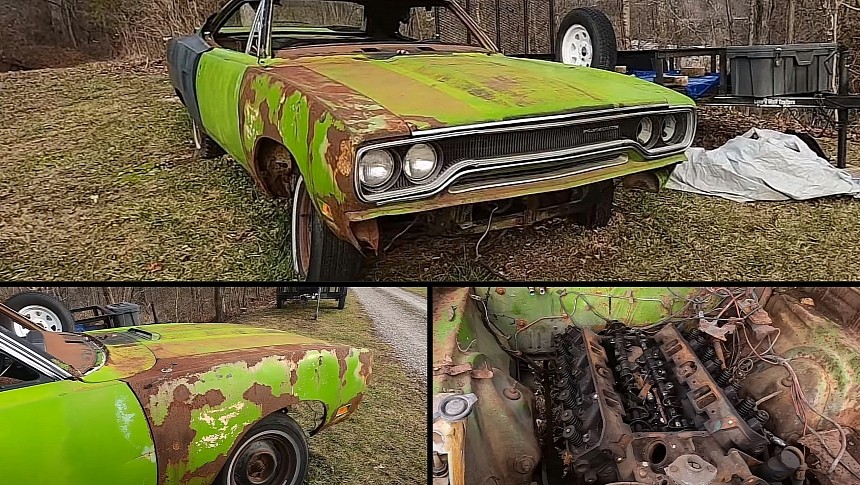As a classic car enthusiast, I get excited whenever I see old rigs being rescued out of barns and junkyards. But not all of them become restored gems. Some are too far gone relative to their values as Concours-ready vehicles and end up as parts cars. It's sad, but it's how the cookie crumbles.
Some, however, get lucky despite looking like perfect candidates for the crusher. The 1970 Plymouth Road Runner you see here is one of those cars. Featured by YouTube's "Newhouse of Speed," this hardtop looks like it has been sitting for a very long time. I'd say at least 30 years, based on the amount of rust.
It has loads of surface rust on one front fender, while the engine hood is rather crusty. Both rear fenders have been replaced at some point, which suggests they probably succumbed to rot from exposure to the elements. The trunk floor is almost gone, and I bet the floor pans inside the cabin are also severely damaged.
Surprisingly enough, however, most of the original body panels are still sporting a vivid shade of green. It's most likely Limelight, a hue Dodge also offered as Sublime under code FJ5. Part of the High-Impact color palette, Limelight was available on Plymouths in 1970, and it was pretty popular.
Or is it Sassy Grass, the slightly darker green marked as FJ6? It's difficult to say with all that weathering on the paint, but I think we're looking at a Limelight rig. Unfortunately, the Road Runner doesn't have a build sheet or a fender tag, so figuring out the options is pretty much impossible.
Which brings me to the engine, yet another mystery surrounding this car. The owner points out that the dismantled V8 under the hood is not a numbers-matching mill. He doesn't know what this car got from the factory, but it's safe to assume it was a 383-cubic-inch (6.3-liter) V8. It was the most popular engine choice at the time.
Plymouth sold 36,861 Road Runners in the US that year, and only 1,967 units got the 440-cubic-inch (7.2-liter) RB Six-Barrel and 426-cubic-inch (7.0-liter) HEMI options. This leaves nearly 34,900 383 vehicles out there. Yup, the Road Runner with the entry-level V8 is far from rare.
However, this specific model is a hardtop, which narrows it down to 20,216 examples. Furthermore, it's also one of 11,639 vehicles equipped with an automatic gearbox. It's anything but scarce even with this number to run by, but there's a reason I'm mentioning it. Even though this Road Runner looks like a car that should meet the crusher, our host decided to give it a second chance.
I'm not saying he will restore it to factory specifications. That would be very expensive relative to the rig's value on the classic car market. This Mopar will probably hit the road as some sort of restomod, but that's still great news. Plymouth may have built tens of thousands of them 50 years ago, but these Road Runners are becoming scarce in any condition. It's one of those projects that's worth following.
It has loads of surface rust on one front fender, while the engine hood is rather crusty. Both rear fenders have been replaced at some point, which suggests they probably succumbed to rot from exposure to the elements. The trunk floor is almost gone, and I bet the floor pans inside the cabin are also severely damaged.
Surprisingly enough, however, most of the original body panels are still sporting a vivid shade of green. It's most likely Limelight, a hue Dodge also offered as Sublime under code FJ5. Part of the High-Impact color palette, Limelight was available on Plymouths in 1970, and it was pretty popular.
Or is it Sassy Grass, the slightly darker green marked as FJ6? It's difficult to say with all that weathering on the paint, but I think we're looking at a Limelight rig. Unfortunately, the Road Runner doesn't have a build sheet or a fender tag, so figuring out the options is pretty much impossible.
Which brings me to the engine, yet another mystery surrounding this car. The owner points out that the dismantled V8 under the hood is not a numbers-matching mill. He doesn't know what this car got from the factory, but it's safe to assume it was a 383-cubic-inch (6.3-liter) V8. It was the most popular engine choice at the time.
Plymouth sold 36,861 Road Runners in the US that year, and only 1,967 units got the 440-cubic-inch (7.2-liter) RB Six-Barrel and 426-cubic-inch (7.0-liter) HEMI options. This leaves nearly 34,900 383 vehicles out there. Yup, the Road Runner with the entry-level V8 is far from rare.
However, this specific model is a hardtop, which narrows it down to 20,216 examples. Furthermore, it's also one of 11,639 vehicles equipped with an automatic gearbox. It's anything but scarce even with this number to run by, but there's a reason I'm mentioning it. Even though this Road Runner looks like a car that should meet the crusher, our host decided to give it a second chance.
I'm not saying he will restore it to factory specifications. That would be very expensive relative to the rig's value on the classic car market. This Mopar will probably hit the road as some sort of restomod, but that's still great news. Plymouth may have built tens of thousands of them 50 years ago, but these Road Runners are becoming scarce in any condition. It's one of those projects that's worth following.












